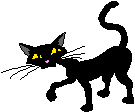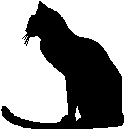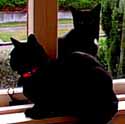|
Clip art images courtesy of Microsoft Free Download Site (note)
by Jamie McKenzie
(About the Author)
- Computer software penetrates and influences our culture in ways that too often escape scrutiny and discussion. The pervasive use of mediocre clip art and templates associated with a narrow range of desktop programs is just one by byproduct of a new trend some are calling "microsoftness1."
-
- While much of this influence is benign, other aspects are quite malignant and even odious. Especially when one or two companies dominate the available desktop applications,
| Just as paint-by-numbers was dismissed decades ago as "fake art," the recent flood of clip art, templates and stock photographs must be viewed critically. These short cuts may weaken the quality of human communication and production as a single Microsoft clip art "car" become the only car most of us will ever see as we sit through countless PowerPoint presentations, read computer-generated brochures and open computer-generated greeting cards. |
we may face what amounts to a creative "wasteland" as original thinking, original art and original design give way to the short cut, the template and the stock image.
-
- There is nothing wrong with templates, clip art and stock photography as long as we do not rely upon them as our sole means of communicating. If they become a kind of TV dinner substitute for real production and invention or if they become a microwave dinner version of effective communication, then the short cut becomes the freeway and the mainline. An occasional fast food binge becomes standard fare and macro diet. The Big Mac becomes the only Mac in town. The MacDisneySoft empire imposes the taste and the style, the trends and the fashions of the times, as millions of writers run their prose through grammar checkers which become the standard for "correctness" throughout the land.
Should anyone care? Does it matter?
Finding the Right Cat
for the Job
- Issue #1 - Lack of Soul
-
- Some clip art is pretty cool, but most clip art lacks soul. Most fails any test of style or quality. Clip art cats, lions, people, dogs, cars and trucks are usually mere caricatures of their real selves.
-
- These clip art images usually fail to express the essence of an object or a being. They oversimplify. They exaggerate. They distort. They stereotype.
-
- Cats appear out of context as silhouettes and simple figures without a window or chair to sit in. Lions stand up proudly without grass or prey in the background to enhance their grandeur.
-
- Look a clip art person in the eye and there is nothing deeper to see. Dull, staring eyes. The clip art person has no soul. The clip art lion loses its ferocity. The clip art horse loses its spirit.
-
- How would you rate each of the following three clip art cats for soul, style and reality, for example?
1.  2. 2.  3. 3. 
As clip art, these cats are not so bad, but they certainly are cartoon images with little of the character captured easily in the backyard with a digital camera.
-
  
- The availability of clip art makes it far too easy for folks to decorate and illustrate their creations with mediocre images that fall short even of comic book quality. Life as cartoon. Visual literacy declines as the lexicon of images narrows. We are gradually forced to portray and view more of life as a comic strip.
-
- In schools that have spent millions on new technologies, cut-and-paste multimedia presentations have become all too popular as students razzle-dazzle us with flickering slides loaded with clip art.
-
- Enterprising schools, families and companies will spend extra money to buy clip art collections. There are many CDs now on the market which offer thousands of images for very little money.
-
- Trouble is . . . most of these still lack soul and quality. If we add more mediocre images, we have done little to address the problem.
-
- Antidote #1
-
- Raise the issue of soul within your work group or school. Open up the clip art libraries. Print out the pictures of office workers and cats. Raise awareness. "Do these images have soul? Are they worth using?"
-
-
-
- Issue #2 - Lack of Choice
-
- The typical clip art consumer relies upon a very limited clip art library, usually turning to the collection which comes bundled with the software program. The offering which accompanies Microsoft Office 1998 for the Mac is remarkably barren, with few images for each category and even fewer images worth using.
-
| Category |
|
Category |
|
| Academic |
3 |
Transportation |
5 |
| Animals |
6 |
Sports & Leisure |
4 |
| Buildings |
3 |
Signs |
3 |
| Cartoons |
9 |
Shapes |
9 |
| Entertainment |
6 |
Screen Beans |
8 |
| Gestures |
7 |
Plants |
1 |
| Household |
6 |
People at Work |
2 |
| Industry |
4 |
|
|
-
- Lack of choice means that the images available will rarely communicate in a powerful manner. When Madison Avenue creates a full page ad for the New Yorker, the advertising agency will spend thousands of dollars getting just the right photograph and just the right image, knowing that a good picture "is worth a thousand words."
-
- The agency lines up just the right people for the image, and they find just the right setting. If they are selling medical care of some kind, they make sure their doctors' faces inspire trust and confidence. They eliminate any models with shifty eyes or hints or arrogance. "Would you buy pills from this man? from this woman?"
-
- They know that soulful images sell more product.
-
- Advertising agencies respect the dynamic relationship between images and words. They see the value of crisp new images which are crafted thoughtfully to accompany text messages.
-
- There is nothing about clip art libraries which prevents anybody from inserting their own photography or line drawings. But the implicit message of these programs is the value of the short cut and the template. It takes a very strong swimmer to resist the current and swim upstream against the flow of clip art and ready made images.
-
- Words and images should work together so that each contributes intensely to the ideas being expressed, but this balance between words and images is undermined when the available collection leaves the communicator with a 2-3 cats, dogs, office workers or cathedrals. Communication is seriously compromised when the writer inserts "any old cat" or "any old cathedral" that happens to be in the clip art library.
-
- Antidote #2
-
- Ask your colleagues and your students to look at powerful ads in great magazines and explore the interplay between image and texts. "How did they do that? Why did they combine these words and images? What are the best ways to expand choice?"
-
- Invest in richer clip art libraries, looking for more powerful images with less of a cartoon feeling.
-
- Invest in digital cameras and ask students to capture important images to add to the school collection. Fill the file server photograph collection with hundreds of cats and dogs and people and houses and flowers and boats and cars.
-
- For an outstanding example of this strategy, visit the Silver Beach Elementary School and see how Dar New, the media specialist, has sent students out into the community to capture images. Go to Kid's Eye Bellingham by clicking here.
http://wwwsil.bham.wednet.edu/Kids%20Eye/kids%20eye1.htm
-
-
- Issue #3 - Lack of Originality
-
- When we learn to look carefully at any one thing, whether it be a person or a duck or a cathedral, we often recognize it as remarkable and unique. We note its particularities. The cathedral may offer a collection of gargoyles setting it off from the rest of the cathedrals of the world (see photographs of the
 gargoyles of Notre Dame by clicking here). gargoyles of Notre Dame by clicking here).
-
-
- But clip art tends to round off all the edges and average out the uniqueness of people, animals and buildings until they take on a glaring similarity. They are often reduced to the "least common denominator." All that is unique or particular and original is eliminated in the search for "every man" or "every woman" or "every duck" or "every cathedral." We become both victims and purveyors of standard fare.
-
- The more time you spend exploring the real cathedral, the more special it becomes. (see more photographs of Notre Dame by clicking here).
-
- We are witnessing the reduction of people, animals, buildings and objects into icons2.
     The iconization3 of celebrities is just one example of this global trend as the real Diana, princess of Wales, disappears in a flurry of biographies, news stories, commemoratives, memorials and souvenirs. Diana on the coffee mug. The iconization3 of celebrities is just one example of this global trend as the real Diana, princess of Wales, disappears in a flurry of biographies, news stories, commemoratives, memorials and souvenirs. Diana on the coffee mug.
-
- We see books on James Dean: the American Icon and Joe Dimagio: the American Icon. But clip art does the same thing to simple, ordinary life objects and regular people.
-
- Even though the process of iconization is moving ahead full force, it is hard to find the word in any dictionary or encyclopedia. Encarta does not define it. Merriam Webster's WWWebster does not define it. Britannica Online does not define it or recognize it.
-
- But HotBot shows 240 "hits" for iconization, some of which refer to the closing and opening of Windows windows and others of which refer to the world of art (New Mexico's Museum of Fine Arts) or the world of entertainment (interview with Sharon Stone - click here to read http://www.etonline.com/html/Interviews/1704.3.html). The term has entered usage but has gained little official recognition.
-
- When we buy software programs we don't think of them as culturally limiting and restrictive, but they often prove to be just that.
-
- Antidote #3
-
- Appreciation of real things grows when we spend time recognizing and enjoying the particular attributes or qualities of those real things. Decades back, Malvina Reynolds wrote a song critical of American suburban life . . . "Little boxes made of ticky tacky, and they all look just the same." She broadened the concern as she sang of the children from these houses growing up . . .
-
- "And then to the university,
Where they are put in boxes,
And they come out all the same. ."
- (click here for full lyrics)
-
- Engage colleagues or classes in the collection of some one thing . . . be it sea shells or pine cones or rocks or butterflies or pictures of cats. Have each person bring 100 examples to class.
-
- "What is it that makes this particular cat special? unique? different from all the rest?"
-
- Take a look at Monet's paintings of cathedrals or haystacks in different light conditions. Same cathedral, but different in different light. Add a dozen other paintings by Monet of other cathedrals. How does this change the concept of cathedral?
-
- Conclusion
-
- The narrowing and limiting of cultural expression is a distinct threat to the quality of human life, just as the substitution of "virtual reality" for reality can cheapen and dilute the authenticity of experience. We find ourselves "reaching out to touch someone" electronically. We find ourselves wandering through the rain forest on our CD-ROM while ignoring the real rain forest in our own back yards. Sometimes new technologies enhance and enrich our experience, allowing us to enjoy with virtual visits cities, museums and destinations beyond our grasp and budgets. But we must be mindful of the limitations which accompany virtual experiences and various forms of software.
-
- Templates and clip art can serve an important and welcome role in society so long as we employ them with discernment and discretion. They can improve communication as long as we exercise good taste and augment them with other images, structures and strategies when they will enhance our message.
-
- Schools and teachers have a responsibility to engage students in thoughtful dialogue about these technological choices so they will emerge as wise consumers and powerful communicators.
-
-
-
-
- Footnotes
-
- 1. An Australian colleague coined this expression but wants no public credit for its invention. Constructive criticism of international conglomerates is essential to health of our democratic societies, but public criticism seems risky to some folks.
-
- 2. Some icons have more soul than others. I am particularly fond of the icons used throughout this Web site which were created by Jay Boersma, who manages to create small images which often carry a strong element of soul. Four of the icons on this line were crafted by Jay. Jay Boersma's site is at http://www.ECNet.Net/users/gas52r0/Jay/home.html.
-
- 3. Iconization: the process of turning something real into something simpler but possibly more symbolic and mythical, especially referring to the treatment of celebrities by the media, but also referring to the transformation of real objects and people into simple clip art or cartoon versions.
-
- Note on Microsoft Clip Art Images used above: The three cats, the school, the eagle and the school supplies images were all found at the MSDN Online Images Downloads site at http://msdn.microsoft.com/downloads/images/ which states:
-
- Here are a variety of images that you can download for FREE. They include rules, buttons, backgrounds, bullets, icons, clip art images, and photographs. Use them to spruce up your Web sites with color and character.
-
- A lot of our images are courtesy of Little Men's Studio, Inc. Little Men's Studio provides original clip art collections, icons, and free quotes on affordable custom graphics. Their Web site
-
- I used the clip art here because it is actually quite good clip art.
-
- At the bottom of this same page there is a far more restrictive statement regarding copyright, but I include the images in this article because the main statement on this page is quite clearly permissive.
Back to April Contents
Credits: The photographs were shot by Jamie McKenzie. Icons from Jay Boersma. Copyright Policy: Materials published in From Now On may be duplicated in hard copy format if unchanged in format and content for educational, nonprofit school district and university use only and may also be sent from person to person by e-mail. This copyright statement must be included. All other uses, transmissions and duplications are prohibited unless permission is granted expressly. Showing these pages remotely through frames is not permitted.
FNO is applying for formal copyright registration for articles.
From Now On Index Page
|
|
 gargoyles of Notre Dame by clicking here).
gargoyles of Notre Dame by clicking here).
